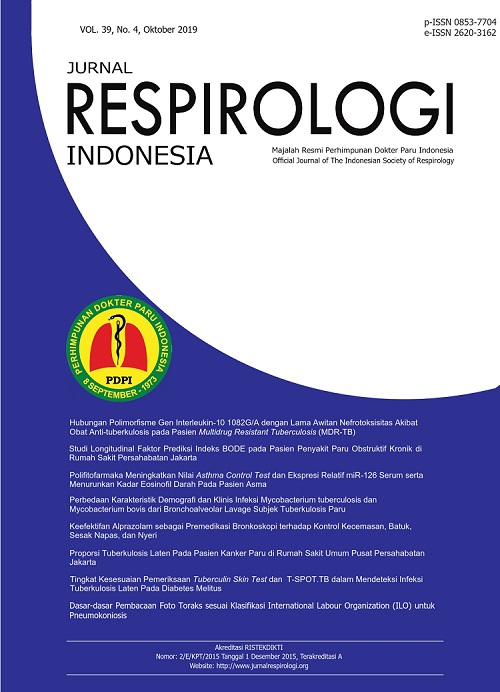The Correlation Between Interleukin-10 1082G/A Gene Polimorphism Late Onset with Nephrotoxicity Secondary to Antituberculosis Treatment in Multidrug Resistant Tuberculosis Patients
DOI:
https://doi.org/10.36497/jri.v39i4.71Keywords:
MDR-TB, IL-10 1082 G/A genotype polimorphism, nephrotoxicityAbstract
Backgrounds: Tuberculosis controlling programme has become more complex with MDR-TB problem. Interleukin 10 (IL-10) 1082G/A gene polimorphism correlates with IL-10 secretion as anti-inflammatory cytokine which plays important role in pathogenesis of MDR-TB infection. The management of MDR-TB which used aminoglycosides could cause nephrotoxic effect to the patients. The protective role of IL-10 from IL-10 1082 G/A genotype to nephrotoxicity due to kanamycin still becomes a prolem nowadays. Methods: This study was a retorspective cohort study of MDR-TB patients who underwent treatment in Dr. Moewardi Hospital in 2011-2015. Results: Subjects of the study were 89 MDR-TB patients with IL-10 1082 G/A genotype polimorphism. The proportions of IL-10 1082 G/A genotype were AA genotype of 13.48%, GG of 4.49%, and GA of 82.2%. Statistic test showed that the onset of nephrotoxicity in GG genotype was faster than GA and AA genotype Conclusions: Interleukin 10 1082 G/A gene polymorphism had no significant correlation with nephrotoxicity onset in MDR-TB patients treated with kanamycin in Dr. Moewardi hospital. (J Respir Indo. 2019; 39(4): 215-9)Downloads
References
Katherine F, Annabel B, Anna D, Hannah MD, Dennis F, Inés G, et al. Editors. Global tuberculosis report. France: WHO Library Cataloguing-in-Publication Data. 2013.
Amalia L, Maidatuz Z, Soeroto AY. Comparative Study Of Kanamycin and Capremicin on Potassium Level of Multidrug Resistance Tuberculosis Patientsat a Hospital in Bandung Indonesia. J Int Pharm Pharm Sci. 2016;8:307-10.
World Health Organiation. WHO treatment guidelines for drug-resistant tuberculosis. Switzerland. WHO. 2016:59-72.
Jose AC, Giovani S, Alimuddin Z, Giovani BM. Best drug treatment for multi-drug-resistant and extensively drug-resistant tuberculosis. Lancet Infect Dis. 2010;10:621-9.
Lopez-Novoa JM, Quiros Y, Vicente L, Morales AI, Lopez-Hernandez FJ. New insights into the mechanism of aminoglycoside nephrotoxicity: an integrative point of view. Kidney Int. 2011;79:33–45.
Bell S, Davey P, Nathwani D, Marwick C, Vadiveloo T, Sneddon J, et al. Risk of AKI with gentamicin as surgical prophylaxis. J Am Soc Nephrol. 2014;25:2625–32.
Paquette F, Bernier-Jean A, Brunette V, Ammann H, Lavergne V, Pichette V, et al. Acute Kidney Injury and Renal Recovery with the Use of Aminoglycosides: A Large Retrospective Study. Nephron. 2015;131:153–60.
Waikar SS, Liu KD, Chertow GM. Diagnosis, epidemiology and outcomes of acute kidney injury. J Clin Am Soc Nephrol. 2008;3:844–61.
Chawla LS, Amdur RL, Amodeo S, Kimmel PL, Palant CE. The severity of acute kidney injury predicts progression to chronic kidney disease. Kidney Int. 2011;79: 1361–69.
Morata L, Cobos-Trigueros N, Martinez JA, Soriano A, Almela M, Marco F, et al. Influence of multidrug resistance and appropriate empirical therapy on the 30-day mortality rate of Pseudomonas aeruginosa bacteremia. Antimicrob Agents Chemother. 2012;56:4833–37.
Wargo KA, Edwards JD. Aminoglycoside-induced nephrotoxicity. J Pharm Pract. 2014;27:573–7.
Sinuani I, Averbukh Z, Gitelman I, Rapoport MJ, Sandbank J, Albeck M, et al. Mesangial cells initiate compensatory renal tubular hypertrophy via IL-10 induced TGF beta secretion: effect of the immunomodulator AS101 on this process. Am J Physiol Renal Physiol. 2006;384-94.
Jaber BL, Prereira BJG, Bonventre JV, Balakrishnan VTS. Polymorphism of host response genes: Implications in the pathogenesis and treatment of acute renal failure. Kidney International. 2005;67:14–33.
Anthony TG, Stanislaw PS, Charles HC, Claire M. Risk factors for aminoglycoside associated nephrotoxicity in surgical intensive care unit patients. International Journal of Critical Illness and Injury Science. 2011;1:17-21.
Mulu W, Mekonnen D, Yimer M, Admassu A, Abera B. Risk factors for multidrug resistant tuberculosis patients in Amhara National Regional State. African Health Sciences. 2015;2:368-77.
Singla R, Sharma SK, Mohan A, Makharia G, Sreenivas V, Jha B. Evaluation of risk factors for antituberculosis treatment induced hepatotoxicity. Indian J Med Res. 2010;132:81–86.
Greenberg AS, Obin MS. Obesity and the role of adipose tissue in inflammation and Griffiths, G., Nyström, B., Sable, S. B. and Khuller, G. K. metabolism 1– 4. Am J Clin Nutr. 2006;83:461–465.
Fen W, Yabin Q, Yunxia T, Duizhi C, Pin C, Zhaolin X. Lack of association between cytokine gene polymorphisms and silicosis and pulmonary tuber¬culosis in Chinese iron miners. J of Ocupational Health. 2008;50:445-54.
Asgharzadeh, M; Ghorghanlu, S; Rashedi, J. Association of promoter polymorphism of interleukin-10 and interferon-gamma with tuberculosis in Azeri population of Iran. Iran J Allergy Asthma Immunol. 2016:15(3):167–73.
Downloads
Additional Files
Published
Issue
Section
License
- The authors own the copyright of published articles. Nevertheless, Jurnal Respirologi Indonesia has the first-to-publish license for the publication material.
- Jurnal Respirologi Indonesia has the right to archive, change the format and republish published articles by presenting the authors’ names.
- Articles are published electronically for open access and online for educational, research, and archiving purposes. Jurnal Respirologi Indonesia is not responsible for any copyright issues that might emerge from using any article except for the previous three purposes.
















